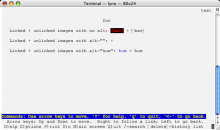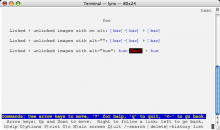Author: mpt
Description:
The auto-generated enlargement icon has alt="Enlarge". This
is needlessly aggravating; if I can't view images, a link
to a larger version of an image is completely useless. So
the icon should have alt="", to hide the link completely in
text-only situations.
(Actually, I can think of one case where a text-only reader
*might* want to see an image page: a Wikipedia admin using
Lynx may still want access to the history page for an
image, in order to investigate vandalism. But that is an
extreme exception, not the rule, and should not sully the
default text-only presentation of enlargable images.)
Version: unspecified
Severity: normal
URL: http://meta.wikimedia.org/wiki/Sandbox/371

